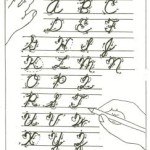January 16, 2012
What Should You Expect of Younger Keyboarders?
Before I answer that question, let’s back up a step and answer a more fundamental question: Should you expect youngers to keyboard? I’m talking about students between kindergarten and fifth grade. Are they mature enough? Do they have the fine motor skills required to use the pinkie to push the A key? Do they have that kind of focus and concentration?
The answer is: Yes, as a rule, though when I reviewed the literature on this subject, it is all over the place as far as when students should/could begin. Some say third grade; some say not until fifth or sixth. From my experience, it’s third grade, though I teach pre-keyboard skills as young as kindergarten. That might be why my students are ready in third grade.
Here’s a caveat: You’ll have to be the arbiter as to whether this is true for your group. If you determine your students aren’t ready, wait a year. You’re the teacher. You’ll know when they’re ready.
Once you decide, the next question is: At what age and how fast should kids type? Here’s a quick answer. Prepare kindergarteners by teaching pre-keyboard skills like posture, hand placement, mouse skills, some shortkeys. This gives their young brains and their immature fine motor skills time to develop. When you determine they’re ready, move on to speed and accuracy.
Me, I’ve come to conclusions that fit my particular K-8 students. Their demographics include:
- private school
- parents support emphasis on keyboarding
- most have computers at home; actually, most have their own computer at home
- students are willing to practice keyboarding in class and submit homework that is oriented to keyboarding
Based on this set of students, here’s what I require:
Kindergarten
An introduction. We use Type to Learn Jr. to introduce keyboarding posture and mechanics, and Brown Bear Typing to challenge them to remember key placement with no emphasis on correct fingers. My students tolerate TTL Jr. and love Brown Bear. Often, when it’s free choice time, they select this program.
Here are hints to develop good habits at this young age:
- Make sure the keyboard remains in front of the student and the mouse to the right (or left for lefties). Students want to push the keyboard out of the way so they can concentrate on the mouse. Don’t let them. Make it a habit to keep the keyboard centered in front of their body with the mouse comfortably on the side
- Keep hands to themselves. Don’t touch others mouse, keyboard, monitor. This gives students a sense of responsibility over their own station, knowing no one can touch it but them
- Keep elbows tucked into their sides
- Keep hands curled like cat paws while typing
- Use the right thumb for the space bar
- Start students on problem solving. Yes, it takes longer to teach them how to fix their volume control, but it takes shorter in the long-run. They feel good about their skills. They remember more than you’ll ever expect. They use it at home which impresses parents with your genius (OK, that’s secondary, but the compliments are nice)
First Grade
More of the kindergarten introduction, with my focus on:
- sit up straight
- elbows at side
- feet in front
- hands on home row and their own side of keyboard
And, we move on to Type to Learn midway through the year. This I tell them is the ‘big kids’ program, one they’ll use throughout Lower and Middle School. They love that.
Second Grade
I still don’t discuss speed, but I begin to focus on traits that allow for speedy, accurate typing:
- good posture
- elbows at their side to force hands into the correct position
- thumb on space bar
- hands on home row
- pointers on f and j
- use the finger closest to the key while keeping pointers on f and j
This year, we don’t use Type to Learn. We move into Dance Mat Typing or Nimble Fingers, where I can focus students on one keyboard row at a time. I also introduce finger exercises (which students get a kick out of) to remind them they have eight fingers and two thumbs–not just two pointers that hunt and peck.
Students work for ten minutes a week in class on only home row for a month. When they feel comfortable with key placement, I cover their hands with a cloth. They love this–see it as a badge of honor to type with hands hidden. By the end of the month, home row is memorized and they’re ready for the QWERTY row. I repeat this process for the next two months with the second and third row. By the fourth month, we return to TTL4, hands covered, no matter how slowly. It feels hard at first and quickly becomes easier.
Third Grade-Fifth Grade
We start on keyboard quizzes for speed and accuracy and filling in blank keyboards for memorization. We use all the good traits acquired in K-2. As students take their speed quiz, I anecdotally notice who is using all fingers. Those that aren’t lose points. Grading is based on improvement from the prior speed quiz. Students who reach the grade level standard for speed and accuracy get a free dress pass (we are a uniform school). This is exciting for them. Grade level standards are:
3rd Grade: 15 wpm
4th Grade: 25 wpm
5th Grade: 30 wpm
I add five hints to the kindergarten list that appeal to the more mature mind:
- Use inside fingers for inside keys, outside fingers for outside keys
- Use the finger closest to the key you need. Sounds simple, but this isn’t what usually happens with beginners.
- Play your keyboard like you do a piano (or violin, or guitar, or recorder). You’d never use your pointer for all keys
- Fingers move, not your hands. Hands stay anchored to the f and j keys
- Don’t use caps lock for capitals! Use shift.
What do you use for Lower School keyboarding? I’d love to hear from you.

Jacqui Murray is the editor of a technology curriculum for K-fifth grade and author of two technology training books for middle school. She wrote Building a Midshipman, the story of her daughter’s journey from high school to United States Naval Academy midshipman. She is webmaster for five blogs, an Amazon Vine Voice book reviewer, ISTE article reviewer, IMS tech expert, a columnist for Examiner.com, and a weekly contributor to Write Anything and Technology in Education. Currently, she’s seeking representation for a techno-thriller that she just finished. Any ideas? Contact Jacqui at her writing office, WordDreams, or her tech lab, Ask a Tech Teacher.





